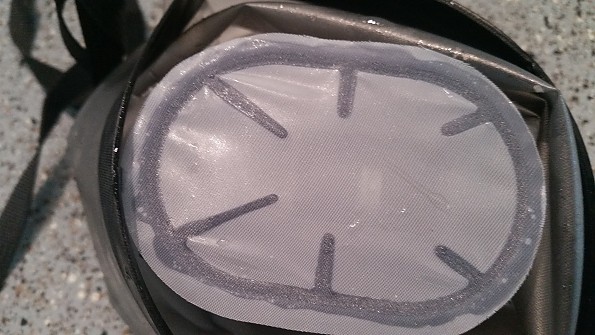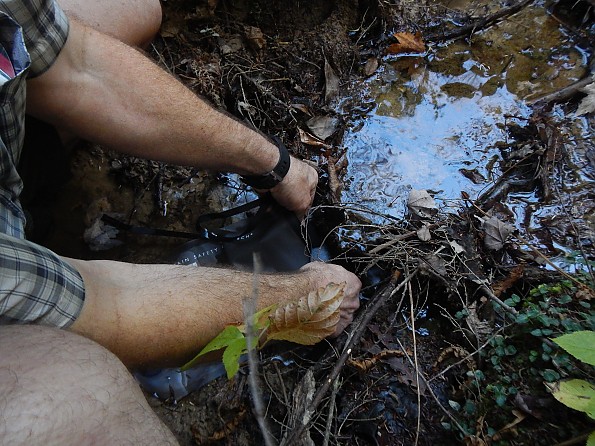MSR Trail Base Water Filter Kit
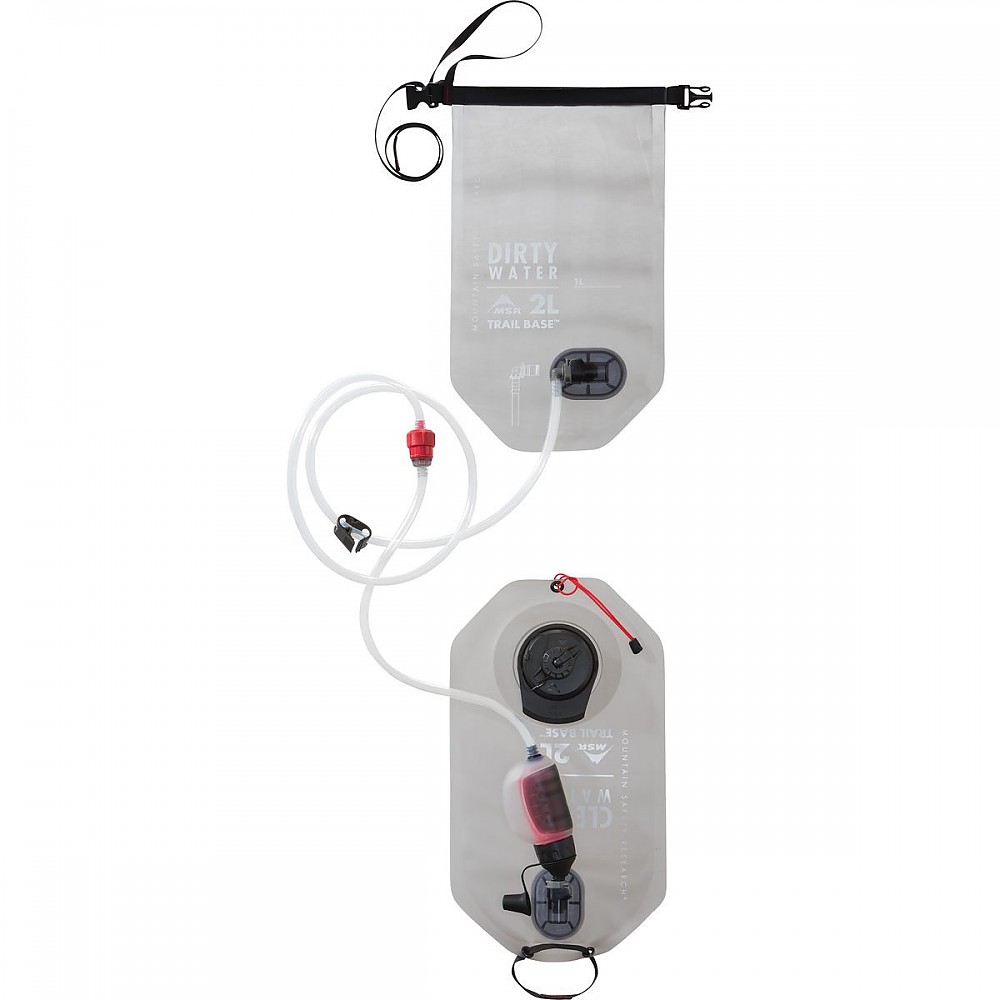
The MSR Trail Base Water Filter Kit is a versatile water treatment device with easy pump and gravity flow setups built in. It could conceivably replace your filter, bladder hydration system and a water bottle for many outdoor activities. A couple of reasons I haven’t switched permanently to this system include weight not suited to a solo hiker like me, initial taste issues (like many bladder systems), and an issue with the pump spout/cap.
Pros
- Versatile—filter, reservoirs, pump, and gravity
- Replaces filter, water bottle, and water storage
- Easy to collect water (even trickles)
- Easy to operate pump filter
- Quick gravity filtering
- Easy to change from pump to gravity
- MSR quality construction
- Reservoirs dry easily (large openings)
Cons
- Heavier/bulkier than other common options
- Initial bad taste takes time to remove
- Slight leakage at spout
- Mesh bag keeps dirty and clean together
- Filter not easy to keep in pocket (freezing temps)
- Dirty reservoir can leak a little if stored full
- Virus/chemicals not filtered (all filters)
- String on small port too short
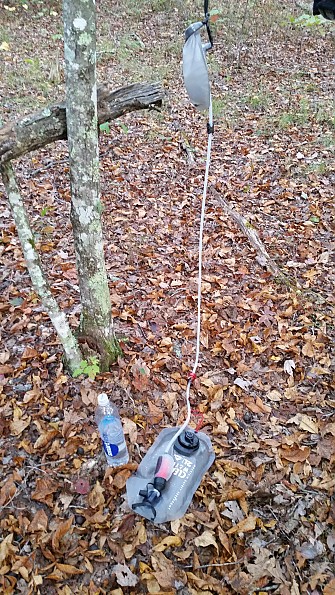 WAIVER: This is not a recommendation for using or not using a filter vs other water treatment options. For those not familiar with the pros and cons of each type of treatment, please refer to Trailspace’s excellent review of these methods.
WAIVER: This is not a recommendation for using or not using a filter vs other water treatment options. For those not familiar with the pros and cons of each type of treatment, please refer to Trailspace’s excellent review of these methods.
QUICK VERSION
I went into a lot of detail below, so if you are short on time or attention span, here is the quick scoop:
I wanted to really like this filter, but the combination of weight/bulk, initial taste issues that lasted a while, and the leaking and weak cap connection reduced the rating for me. Fix the leaking/weak cap issue and this item deserves a 4+ rating.
I think this is a fully functional and very versatile filter system that would be great for a family or group, but too much for a solo hiker unless you are dry base camping. It could replace your entire hydration system including a bladder, but the clean reservoir may not be shaped just right for your sleeve.
Switching between pump and gravity filter is a breeze, and the gravity works fast. The flexibility of use from day hikes, backpacking trips, and base camps make it worth serious consideration if the cap/spout can be tweaked a bit (or if this was just a pre-production issue).
TESTING
I tested the MSR 3 in 1 Water Filter System from October 2017 to February 2018. Temperatures ranged from low 20's (degrees F) to mid 70s. This included four 2-3 night backpacking trips in the southeastern mountains of NC, TN, and VA, along with numerous (estimated 15-20) day hikes of 8-12 miles where I refilled water along the way. Needless to say, my inner nerd came out as usual on a Review Corps test, and I spent a lot of time in the lab (kitchen) performing “science”. I estimate that I have filtered at least 100 liters of water through the system (or some of its components) between field and lab tests.
DESIGN/CONSTRUCTION
Design & Features
The MSR Trail Base system contains several parts:
Water filter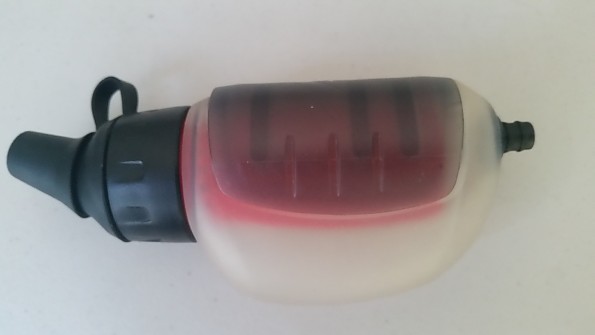 17-inch leader tube with pre-filter on the end
17-inch leader tube with pre-filter on the end Clean water reservoir with quick connect fitting for filter and the MSR 3-port system for dispensing
Clean water reservoir with quick connect fitting for filter and the MSR 3-port system for dispensing Connector hose (48-inch) that screws onto the pre-filter, quick-connects to the dirty reservoir, and has a clamp to switch the gravity on/off
Connector hose (48-inch) that screws onto the pre-filter, quick-connects to the dirty reservoir, and has a clamp to switch the gravity on/off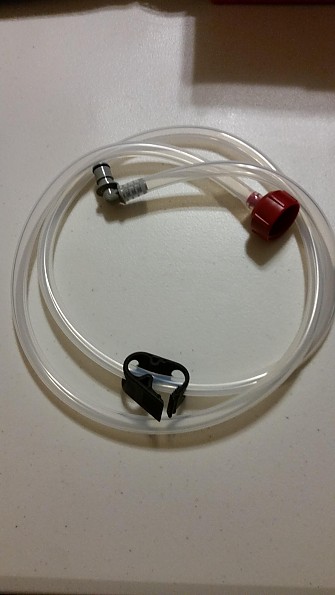 Dirty water reservoir with quick connect fitting and a “dry bag” opening that can be sealed
Dirty water reservoir with quick connect fitting and a “dry bag” opening that can be sealed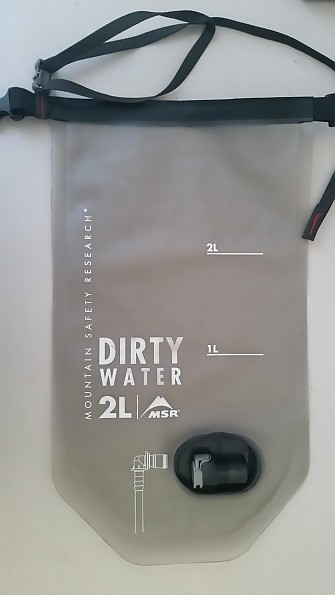 Mesh carry bag to house everything
Mesh carry bag to house everything
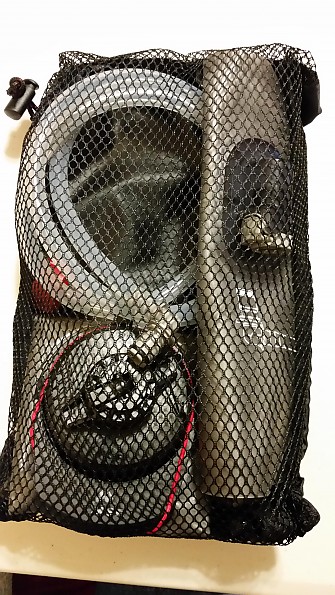 Going from top to bottom there are some key features:
Going from top to bottom there are some key features:
“Dry bag” closure of the dirty water reservoir Clamp for the on/off gravity setting
Clamp for the on/off gravity setting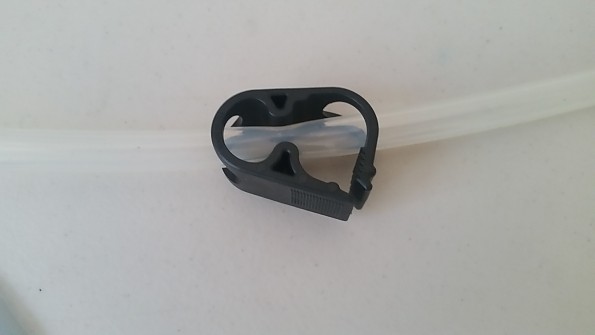 Quick connects on both the dirty and clean water reservoirs
Quick connects on both the dirty and clean water reservoirs Prefilter junction between the Filter intake and dirty reservoir connector
Prefilter junction between the Filter intake and dirty reservoir connector Pump filter with clear casing to see how things are flowing
Pump filter with clear casing to see how things are flowing
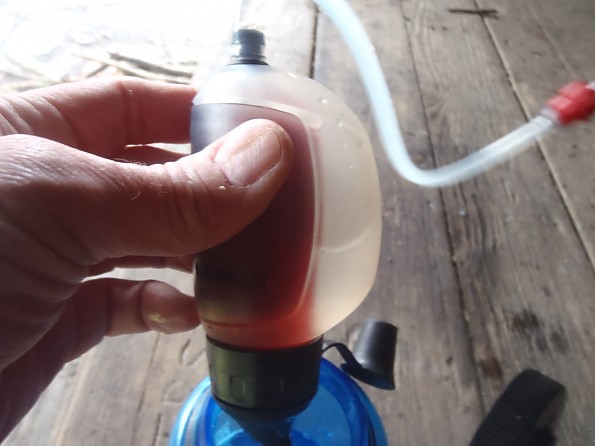 Removable filter spout
Removable filter spout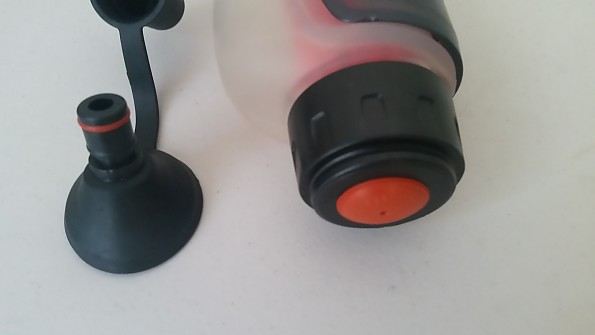 MSR 3-port option on the clean water reservoir
MSR 3-port option on the clean water reservoir
The design results in a flexible system that can be used in several ways:
- Trail Base filter only: An on-the-go direct filter (think LifeStraw) to draw water directly from the source and drink
- Trail Base filter and water bottle: Similar to option 1 but with your own bottle to fill up for later
- Trail Base filter and clean water reservoir: Pump filter into the clean reservoir to drink from later (or hook up like a hydration bladder possibly?
- Full system: Collect water in the dirty reservoir and either pump or gravity filter to the clean reservoir or a bottle as shown previously.
The two water reservoirs add up to 4 liters of capacity, so if you stop and filter into the clean reservoir and carry the dirty one full as well, you have a whopping 4 liters of water for a later dry camp (although a heavy pack!).
I think the design is really smart and produces a flexible product with only two noticeable issues (one minor and one major):
The quick-connect fittings on the reservoirs limit your ability to switch out with another storage system like a Platypus bag. You could still pump or gravity filter to another storage container, but it wouldn’t be as handy.
My biggest problem with the design is the potential for cross-contamination: The carry sack that houses both the clean and dirty components together. This is obviously easily avoidable by splitting into your own bags, but I don’t like the way this is presented like a complete system leaving unsuspecting folks to consider housing them together. I would prefer two carry sacks (both smaller) labeled or color coded. I reverted quickly to using the mesh bag for the dirty water reservoir and connector hose and storing the filter and clean water reservoir on the other side of my pack.
Another less major cross-contamination issue is the filter intake tube are always used as part of the filter, so you have more exposure to unfiltered water along the tube and pre-filter. They even come packaged together initially.
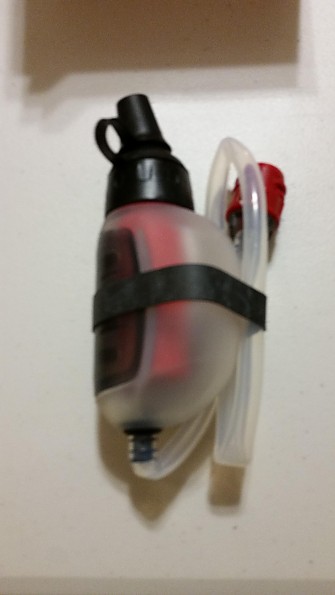 I usually removed this from the filter so that the pre-filter and tube are stored with the dirty water components and the only cross-contamination issue remaining is the small nipple at the base of the filter (similar or smaller exposure than most other filters).
I usually removed this from the filter so that the pre-filter and tube are stored with the dirty water components and the only cross-contamination issue remaining is the small nipple at the base of the filter (similar or smaller exposure than most other filters).
MSR’s instructions address the cross-contamination: “Keep the inlet hoses, prefilter, and other potentially contaminated parts away from filtered water to prevent cross-contamination.”
I would prefer if this was followed through into the design with separate bags etc. for those who don’t read instructions, although I guess that’s their fault in the end. The spout does come with the cap built in, so the only real outlet of filtered water is protected (as long as the clean reservoir is separated).
One more note, the filter with the Trail Base system looks similar to MSR’s TrailShot filter, but the fitting is apparently different so the TrailShot spout won’t work with the quick-connect fittings. It looks like you might be able to switch the caps out, but the other parts are not sold separately that I can find. Photo from MSR TrailShot web page
Photo from MSR TrailShot web page
The TrailShot (above) spout is not long enough to fit into the quick connect below.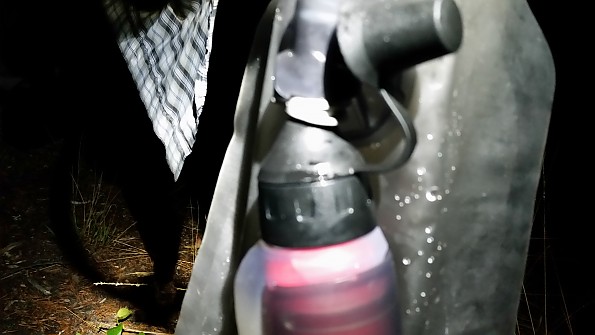
Materials, Construction, & Durability
The filter system is built with typical MSR solid construction. The MSR 3 in 1 clean reservoir spouts are sturdy and allow flexibility in output/filling. The filter has lived in my pocket for most of my winter trips to prevent freezing and suffered no damage. I didn’t poke a hole in either of the reservoirs even though they often rode in my pack side pockets, so they seem durable enough for the occasional brushy limbs etc.
It’s difficult to test reservoir durability unless you aren’t going to use it again and have a knife handy! The rubber hose froze on several nights but was never damaged and thawed easily. Overall, I found it to be well built with solid materials so no issues are expected more than the usual baseline possibility of puncturing a water reservoir.
Size & Weight
The MSR Trail Base is not a small system. Its component parts are intended to provide anything from a trail drink to a full base camp set up. You can’t expect a complete package like that to be small. That said, it does fit into the provided carry sack which measures 7 by 12 inches. However, as discussed above, I would not recommend doing that on a regular basis.
The component parts weights are shown in the table below. Oddly I found that the MSR specifications (which weren’t available on my pre-production model) are much higher than my measurements (by component parts summed and total weight measured together). This may mean there has been a tweak to the system since I received mine in October 2017.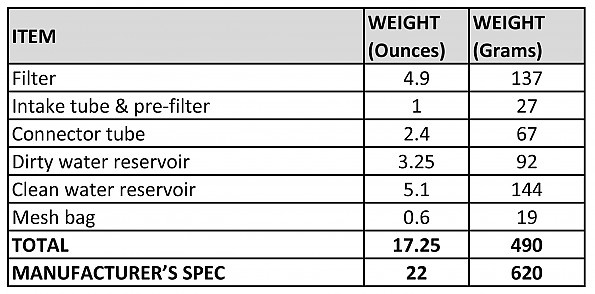 Compare this to my previous water filter system (Sawyer Squeeze and two 2-liter bags) weight of 6.5 ounces/182 grams and you can see that the MSR Trail Base's versatility comes at a weight cost of almost 11 ounces (and some folks carry smaller systems than I do). But that is comparing apples to oranges as those two systems don’t do exactly the same thing. I consider this system way too heavy for a solo backpacker to use regularly, but great for a family or group camp.
Compare this to my previous water filter system (Sawyer Squeeze and two 2-liter bags) weight of 6.5 ounces/182 grams and you can see that the MSR Trail Base's versatility comes at a weight cost of almost 11 ounces (and some folks carry smaller systems than I do). But that is comparing apples to oranges as those two systems don’t do exactly the same thing. I consider this system way too heavy for a solo backpacker to use regularly, but great for a family or group camp.
The size of the filter and pump also make it difficult to carry in cold weather. I take a filter almost year round now for treatment of water, but am well aware that even a small amount of water frozen in a filter can compromise it. My SOP is to carry it in a pocket at all times except during use and rely on my body heat to prevent freezing. With the Trail Base, this was a little tougher to do as it is bulkier than my Sawyer—not a huge difference but a little wider so not as streamlined.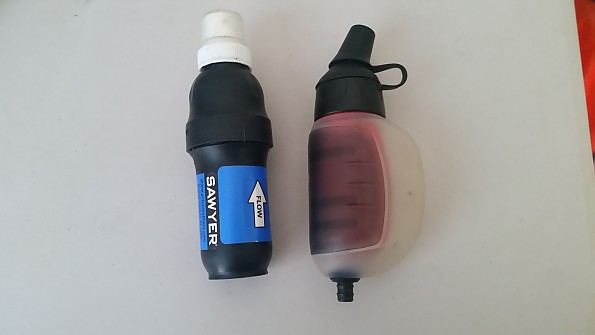
Capacity & Filtration
According to MSR, the Trail Base filter has the capacity to treat 400 gallons/1500 liters before replacement. This should be sufficient for a lot of backcountry use. Assuming 2-4 liters per day that gives you a range of 375 to 750 days in the wilderness worry free of water issues (except aforementioned virus/chemicals).
The hollow fiber filter pore size is 0.2 micron and, based on MSR’s information, can filter bacteria, protozoa, and particulates. As with most filters, it cannot prevent chemical and virus contamination (see waiver at the beginning of this review and Trailspace’s excellent summary of water treatment options).
FUNCTION/OPERATION
Here is a rough overview of the whole system—apologies for quality of the filming and narration—it was a cold day and I was hungry waiting for soup to boil!
Speed
My trail notes over the last four months consistently say “fast” in relation to the MSR Trail Base. Their specs suggest it has a 1 liter per minute flow rate. The gravity system works really quickly in the field. I ran several tests in the lab/kitchen and also on the trail in a couple of convenient Appalachian Trail shelter lunch stops. Gravity filter times ranged from 0.5 to 1 liter per minute.
The one exception was in the video above where it took 3.5 minutes to filter 2 liters. I figured out later that there was a bit of ice build up in the tube that could have easily been cured by just flexing the tube.
In the video below you can see the actual flow rate of the gravity filter. Both the videos above and below are toward the end of the test period and without any cleaning of the filter or pre-filter, so likely slower than my measured times.
The pump filter option is still pretty fast, but definitely takes more effort obviously than the gravity option. My results were around 0.5 liters per minute but you could probably pump faster as the filter refills quickly (see video below for a fast pump rate due to cold rather than being in a rush).
Ease of Use
The MSR Trail Base system could not be much easier to use. I had basically no learning curve on the system. My sample did not come with instructions beyond the pictures on the box, but the MSR website has a full PDF of the instructions so I assume they come with the full model now. The gravity filter is quick and easy to set up. Simply hang the dirty water reservoir (after opening the “dry bag” closure) using the adjustable strap and clip, connect the tube (with the clamp closed) to the quick connection on the dirty reservoir, screw the tube fitting onto the filter intake hose, and connect the filter spout to the quick connect on the clean reservoir. After that simply unclamp the hose and you are good to go!
The gravity filter is quick and easy to set up. Simply hang the dirty water reservoir (after opening the “dry bag” closure) using the adjustable strap and clip, connect the tube (with the clamp closed) to the quick connection on the dirty reservoir, screw the tube fitting onto the filter intake hose, and connect the filter spout to the quick connect on the clean reservoir. After that simply unclamp the hose and you are good to go!
While fellow Review Corps member, Patman, and I were out and about in Tennessee our last water source before a dry camp turned out to be just trickling along. The open end of the dirty reservoir made collection easy as it molded to the stream bed without stirring up much debris. We collected enough water that way for both of us.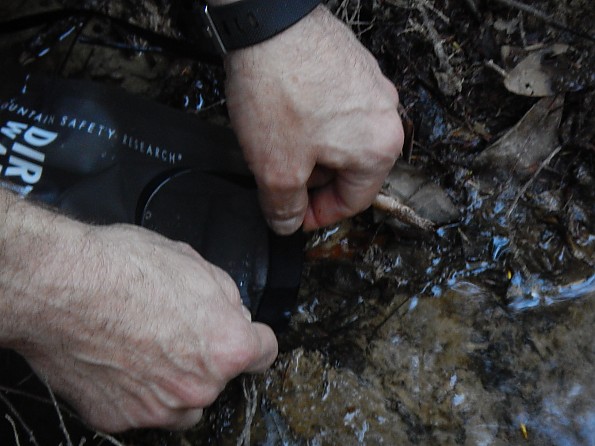 Photo courtesy of Patman
Photo courtesy of Patman
If you have more than a trickle, collection is a snap with the dry bag closure. This is especially useful in cold weather instead of having to immerse your hand for a while as a small-spouted bag fills up. Just a matter of seconds to fill the dirty reservoir...
I find the pump system to be easier to work than my Sawyer Squeeze. By that I mean that my hand hurts less (tend toward a bit of joint pain nowadays) from the repeated pumping than from the continuous squeezing. I would bet that this is a very personal view and each user would have an opinion, so suit yourself.
The video below shows a “fast” pump approach—you can do it slower but it was about 20 something degrees and raining, so I was wanting to keep moving pretty fast!
The dirty reservoir is not bad for on the go water storage, such as picking up a couple of liters before hiking up a hill to a dry camp (about 2/3 of my camps are like this). The first time I tried this the water sloshed around a lot and leaked into the outside pocket of my pack. I found through trial and error that I need to wrap the dry bag closure about four times to ensure a good seal—one less and it leaks a bit especially if you are sloshing up a hill. With a full 2L you can only wrap it three times, so usually get a little leakage. A little less water and four folds stops this.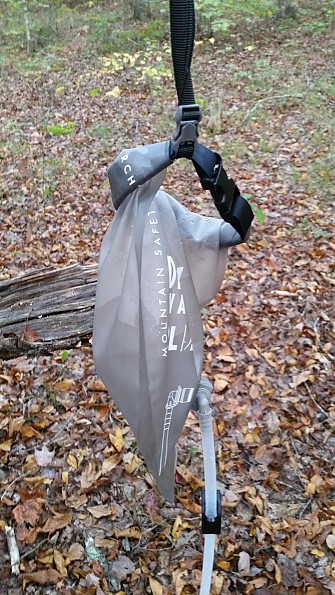 The only part of the system I find not easy to use was the “medium” cap on the clean water reservoir. There was a string attached that was, I assume, meant to keep you from losing the cap. It was short enough and at an angle where it just kept getting in the way. I removed it and take my chances on the cap (I have a spare from an old MSR Dromedary bag just in case).
The only part of the system I find not easy to use was the “medium” cap on the clean water reservoir. There was a string attached that was, I assume, meant to keep you from losing the cap. It was short enough and at an angle where it just kept getting in the way. I removed it and take my chances on the cap (I have a spare from an old MSR Dromedary bag just in case).
The clean and dirty reservoirs both have wide openings so they are easy to dry out after rinsing. Something that is not the case on a lot of Sawyer or Platypus bags, which never seem to dry between trips (as long as I am getting out frequently enough!).
Clogging/Leaking/Maintenance
Filtration seems to work well. I would guess (sorry, forgot to keep track), that I have filtered over 100 liters at this point and there is no noticeable difference in flow rate. MSR claims the filter can handle 1500 liters before replacing.
From the gear maintenance standpoint, the system is easy to clean. I haven’t had to backflush the filter yet, so I assume the pre-filter is working well. It still looks relatively clean. Both filter and pre-filter maintenance instructions are easy—although I do find MSR’s recommendation of cleaning the filter every 8 liters rather intensive. Thankfully the cleaning involves just filling the bulb then shaking it for 20 seconds, removing the intake hose (with the pre-filter) and squeezing the water back out. I must admit, as easy as it sounds, I haven’t remembered to do it that much.
The pre-filter cleaning suggestion is just to swirl it in water if clogged, which I haven’t found to be an issue yet. There have been no clogs, or other issues, beyond the tubing freezing on a cold night around 5,500 feet in snow, ice, and teen temperatures. The outlet from the dirty water reservoir is raised off the bottom slightly which allows sediment to settle without draining through the screen.
Leakage is a different issue. This is where the Trail Base lost some of its rating for me. There is often a small amount of water leaking around the quick connection between the filter and the clean water reservoir. First, the spout doesn’t seem to seal to the filter every time so there are occasional small leaks like this...
However, more of an issue is that if you are using the gravity mode and not paying attention you can knock the hose and pull the larger filter cap off. I did this when messing around in the vestibule of my tent during a snow storm and didn’t notice for a few seconds that the gravity flow of water was spilling out, and there was backflow from the clean water reservoir as it was relatively full and the spout stayed connected, keeping the quick-connect fitting open.
I lost about a ¼ liter of water before I noticed although it’s difficult to see in this photo after stopping the backflow. I did get a laugh out of this as it reminded me of the movie Airplane scene with the IV and guitar playing. 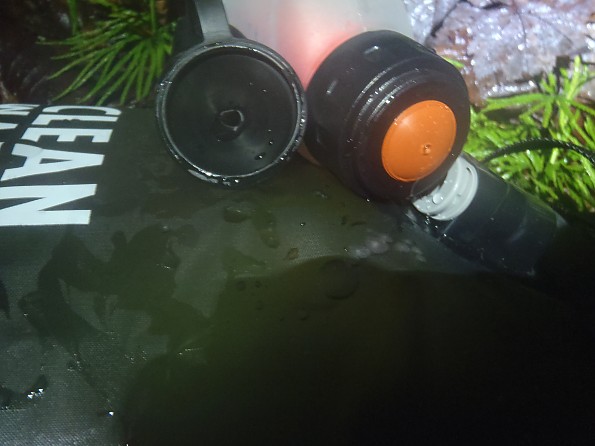
I should emphasize that this doesn’t happen every time. It is a two-piece spout with a removable cap followed by a removable spout that nests on the larger filter outlet (red area above). The spout fits into the quick connect on the reservoir. I assume it either doesn’t sit on the filter well or gets loose occasionally since I don’t usually remove it. It is rather easy to pop the spout off the end of the filter...
Effectiveness
In order to test the effectiveness of the filter, I decided to hydrate for a full day from just toilet water... just kidding! Honestly, my only evaluation of the filter effectiveness is that I didn’t get sick after drinking at least a hundred liters of water from various backcountry sources. I didn’t seek out nasty water of any kind, and in fact tend to be picky in my water source use.
I try to review ahead of time the land use within the drainage area of potential water sources and mark ones that may be suspect (upstream cattle, mining, etc.) if I am not collecting directly from a mountain spring. The worst water I filtered was actually on the trip with another Review Corps member, Patman, where we used the dirty reservoir to capture a seep before looking for a dry camp that night...but even that was directly groundwater discharge high in the watershed so relatively safe from chemicals and viruses.
Since this is MSR, with a long history of quality filtration and purification systems, I take their specs regarding filtration effectiveness (see above) at face value with full confidence. The hollow fiber filter is proven technology as long as it is treated with care. MSR states that the filter is 0.2 micron pore size, and effectively removes bacteria (99.9999%), protozoa (99.9%) and particulate.The hollow fiber filter meets U.S. EPA drinking water standards and NSF protocol P231 testing standard (I took this from the MSR website so feel free to google these standards for more information.
Note that the "gap" in the filter seen below is actually sealed and nothing passes through that area.
Taste
While filters are not purifiers and won’t affect taste that much, I still focus on this when evaluating water treatment. Mountain stream and spring water doesn’t need much help to taste good if you ask me so I just want something in most cases that takes the tasteless, nasty buggies out. Therefore, I was surprised on my first trip when I detected a chemical taste to the water. Fellow gear tester Patman confirmed this (in fact I think he noticed it first).
Not happy with our sample size of two, I performed some blind taste tests at home with family members over the holidays (got to expect something like this if you decide to hang out with a backpacking nerd at Christmas!). The labels were hidden from view but I had folks taste several different processes using City water, which has a slight chlorine taste (we usually run our water through a carbon filter at home so it was noticeable).
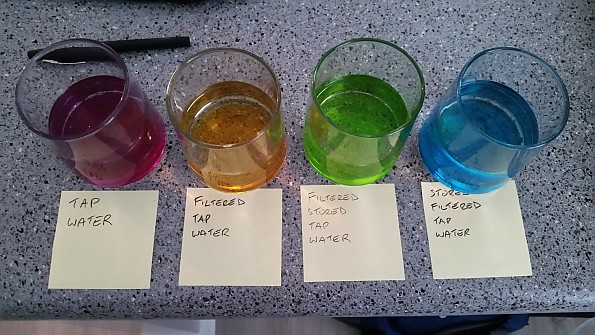 After multiple uses and rinsing, there was a general consensus that:
After multiple uses and rinsing, there was a general consensus that:
- Tap water – chlorine taste
- Filtered directly to glass – no taste
- Filtered and stored in clean reservoir – chemical taste
- Stored in dirty reservoir then filtered – chemical taste
This confirmed for me that the chemical taste was coming mostly from prolonged storage in the reservoirs. I conferred with our Review Corps folks—a very experienced group—and took the suggestion to soak and rinse the reservoirs with a mixture of baking soda and water. I left the reservoirs in the solution (or vice versa actually) overnight then did some serious rinsing and soaking. With the same crack team of tasters, we found:
- Tap water – chlorine taste
- Filtered directly to glass – no taste
- Filtered and stored in clean reservoir – some chemical taste
- Stored in dirty reservoir then filtered - some chemical taste
So we had similar results, but a little less taste after the baking soda treatment, and really confirmed that the taste issue was coming from the reservoirs (and as expected wasn’t removed by the filter). I have not used hydration bladders much, as there is often a similar issue with taste initially. This bothers me as I don’t know what I am consuming.
The taste went away finally but it took a lot of use and rinsing to make it undetectable. The rubbery material used in the construction of the reservoirs is different from Platypus and Sawyer bags, which I have found no taste trouble with. Keep in mind this was also a pre-production model so it may not be as bad in the full production.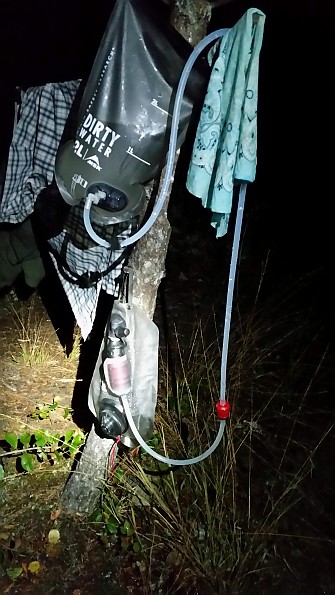 FINAL WORD (At Last!)
FINAL WORD (At Last!)
I recommend looking into the MSR Trail Base Water Treatment System if you hike in groups or with the family. A great idea from a great company that just wasn’t right for my style of solo backpacking, with initial taste issues although they passed and may not be present in full production models. I think a tweak to the filter pump cap to address the occasional looseness and leaking, and this would be an excellent choice for your next group trip.
Thanks to Trailspace and MSR for the opportunity to test this water treatment system.
Source: received for testing via the Trailspace Review Corps
(Sample provided by MSR for testing and review)



